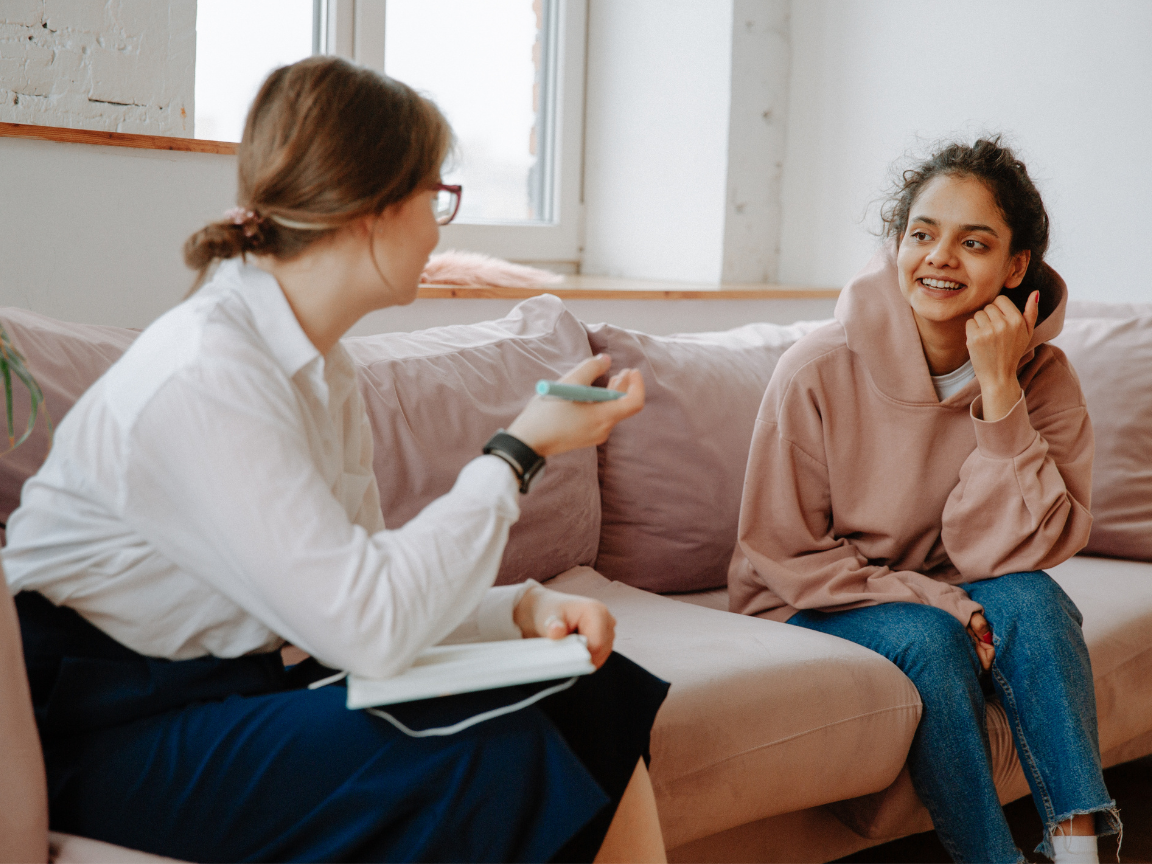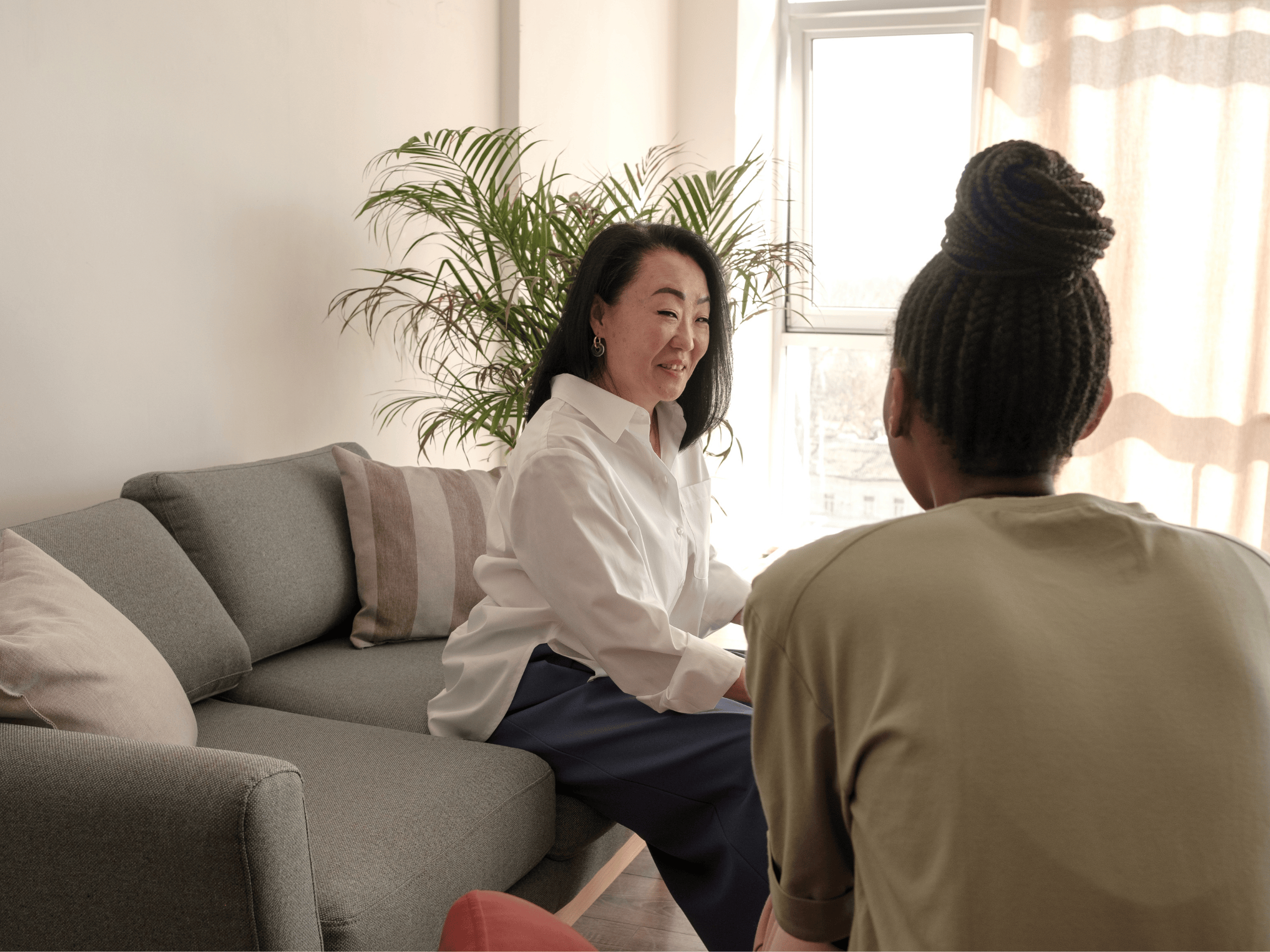Online Group Therapy
Toronto, Mississauga, GTA & Across Canada
Our experienced group therapists offer affordable online group sessions to support clients.
Upcoming Group Therapy Sessions:
Building Coping Skills for Trauma
This group therapy focuses on teaching: psychoeducation on trauma, how it affects us, whattrauma processing means and building coping skills to help with regulation.
Dates: TBD (10-weeks recurring)
Location: Online via Zoom
Time: 8-9pm EST on Tuesdays
Cost: $100/session
Mindfulness-Based Stress Reduction: 8-Week Course
This group therapy focuses on teaching mindfulness based coping skills for stress reductionand coping with various mental health concerns.
Dates: TBD (8-Weeks)
Location: Online via Zoom
Time: 7-9pm EST on Mondays
Cost: $550 (For 8 weeks)
*Our groups run based on availability and number of spots filled. Let us know if there are any topics you would like to find groups on as we are constantly exploring ways to add more topics in the future!

Benefits of Group Therapy
These are some reasons why group therapy sessions can be helpful and effective option for mental health support:

Sense of Belonging
Being part of a group builds community and connection. It can strengthen a person’s ability to give and receive empathy, which helps heal feelings of disconnection. Members often feel more motivated to work on their goals when others are in the journey with them.

Shared Understanding
Group therapy offers a space where people realize they are not alone in their struggles. Hearing others share similar challenges reduces feelings of isolation and normalizes experiences. It also bring in different viewpoints and coping strategies, helping participants learn from each other.

Cost-Effectiveness
Group therapy is more affordable than individual sessions, making it easier to access professional support. It offers more time with a therapist for a lower fee, and often works well alongside individual therapy to balance care and cost. This can makes mental health support more sustainable.
Frequently Asked Questions on Group Therapy
Group therapy is a structured form of counseling where several people meet together with a trained therapist. Each group is designed around a specific focus, such as coping with trauma, reducing stress, or improving relationship skills. The sessions combine professional guidance with the unique support that comes from peers.
Sessions follow a predictable rhythm: a check-in, a guided exercise or discussion, and a wrap-up. Participants are encouraged to share at their own pace. No one is ever required to talk more than they feel comfortable, and confidentiality is always emphasized.
Unlike individual therapy, which focuses only on your personal story, group therapy allows you to see yourself reflected in others. Participants often realize that someone else’s story feels strikingly familiar, which can be both validating and healing. The group becomes a safe space to share, listen, and grow together.
Group therapy helps in two powerful ways. First, it gives you access to a trained therapist who introduces tools, skills, and therapeutic frameworks. Second, it surrounds you with participants who are also navigating challenges, creating a sense of connection and encouragement.
In this environment, participants learn coping strategies, receive feedback, and practice new ways of relating in real time. For example, someone who finds it difficult to speak up might practice doing so in group, and immediately hear encouragement from others. Another participant might discover that their own strategies for managing anxiety inspire someone else to try a new approach.
The benefits go beyond skill-building. Group therapy reduces isolation, helps people feel validated, and strengthens confidence through shared growth. Because you are not just hearing from one professional but from a whole group of people, you benefit from multiple perspectives and a wider range of solutions. Over time, this blend of professional guidance and peer support becomes a powerful foundation for long-lasting change.
Both forms of therapy have unique strengths, and many people choose to do both at different points in their journey.
Group therapy may be the right choice if:
- You want a more affordable option that still provides professional guidance.
- You value learning from others who are experiencing similar challenges.
- You are looking for a sense of community and connection.
- You want to practice new skills, such as setting boundaries or speaking up, in a supportive environment.
Individual therapy provides private, focused attention, while group therapy lets you learn and grow in a shared space. The two can complement each other beautifully. For instance, you might explore personal history in individual sessions, then practice skills and gain real-time feedback in group. Many people find that the combination of the two leads to faster and more sustainable progress.
Group therapy can support a wide variety of people. It may be especially beneficial if you are:
- Coping with trauma or difficult past experiences.
- Struggling with anxiety, stress, depression, or other mental health concerns.
- Grieving the loss of a loved one.
- Adjusting to major life transitions such as moving, parenthood, or career changes.
- Seeking healthier relationships and stronger boundaries.
- Hoping to build confidence and improve self-esteem.
Group therapy is also a good fit for students balancing academic pressure, professionals experiencing burnout, or parents who feel stretched thin. Some participants join to learn practical coping strategies, while others are motivated by the desire to connect with people who understand.
The diversity of participants is part of what makes groups so powerful. Whatever your reason for joining, group therapy provides a supportive space to learn, grow, and connect.
Confidentiality is one of the most important foundations of group therapy. At the first session, the therapist explains clear guidelines: what is shared in the group stays in the group. Each participant agrees to respect privacy and not repeat details outside of the session.
While no setting can be guaranteed completely risk-free, groups rely on mutual trust. Most participants take confidentiality seriously because they want their own stories protected as well. The therapist actively upholds this boundary and creates an environment where participants feel safe enough to be open and honest.
This commitment to privacy is what allows participants to share personal experiences without fear of judgment or exposure. It is the foundation that makes the group space feel safe, respectful, and healing.
Although both provide connection, there are key differences. A support group is often peer-led and focuses mainly on open sharing. Group therapy, on the other hand, is facilitated by a licensed therapist.
In group therapy, the therapist introduces evidence-based strategies, guides structured exercises, and manages group dynamics. They make sure the space feels safe and balanced, and that everyone has the opportunity to participate. The therapist also helps participants notice patterns, process emotions, and translate insights into meaningful changes.
Support groups can be very valuable, but group therapy offers the added advantage of professional guidance. Many participants find that the combination of structured exercises, clinical insight, and peer connection makes the experience more impactful than a peer-led group alone.
Each session follows a clear rhythm so participants know what to expect. A typical session includes:
- Check-in: Participants share briefly how they are arriving that day. This helps build connection and gives the therapist a sense of the group’s energy.
- Guided activity: The therapist leads a structured exercise. This might include psychoeducation on stress or trauma, a mindfulness practice, or a coping-skills activity.
- Discussion: Participants reflect on the exercise, share their experiences, and support one another. This is often where the richest learning occurs.
- Wrap-up: The session closes with key takeaways and practical strategies to practice before the next meeting.
This rhythm creates consistency and safety, while still leaving room for spontaneous discussion and connection.
Typical groups range from 8 to 15 participants, depending on the type of group and its focus. This size is intentional. It is large enough to offer a wide range of perspectives but small enough to give each person space to speak and be heard.
Smaller groups may feel more intimate, allowing for deeper conversations and greater individual attention. Larger groups bring more diversity in experiences and coping strategies. Both have value, and the therapist ensures that everyone has the chance to participate in a balanced way.
It is normal to feel nervous before your first session. Many participants worry that they will not know what to say or that they will feel uncomfortable sharing personal details.
At first, most participants listen more than they talk. Simply hearing others share similar struggles can be surprisingly comforting. As trust builds, people naturally begin to share more at their own pace. No one is ever pressured to speak before they are ready.
By the second or third session, many participants notice their nervousness has eased. Some even come to look forward to the group as a highlight of their week because it provides a rare space of empathy, acceptance, and understanding.
There is no special preparation required. The most important thing is simply to show up with an open mind. Many people feel anxious at the beginning, and that is completely normal.
A few gentle ways to prepare include:
- Thinking about what brought you to group therapy and what you hope to gain.
- Writing down a few thoughts or questions you might want to share.
- Reminding yourself that listening is just as valuable as speaking.
The first session usually focuses on introductions and group guidelines. Most participants leave feeling more at ease than they expected, reassured by the fact that others felt just as nervous at the start.
Life is unpredictable. Illness, travel, or other responsibilities can sometimes mean missing a session.
If this happens, you are welcome to rejoin at the next meeting. The group will keep moving forward, and the therapist can provide a short update if you feel you need it. While regular attendance helps you get the most out of the experience, missing an occasional session will not erase the progress you have already made.
Many groups also share handouts or practice exercises, so even if you miss a week, you can still stay engaged and continue your growth outside of the session.
Yes. Research and participant experiences show that online group therapy is just as effective as meeting in person. Participants still see each other, share stories, and build meaningful connections.
For many, online therapy is even more accessible. Being able to join from home reduces barriers like commuting, mobility issues, or scheduling conflicts. Some participants say they feel more comfortable opening up from their own familiar environment.
The therapist ensures the online space is engaging and supportive. With clear guidelines and interactive exercises, participants report that online groups feel just as connected and impactful as in-person sessions.
Group therapy is generally more affordable than individual sessions, which makes it a more accessible option for many people. Because the therapist’s time is shared, each participant pays less while still receiving professional support.
Some participants also combine group and individual therapy to balance care and budget. For example, they may attend weekly group sessions and schedule a private check-in with an individual therapist once a month. This blended model allows them to benefit from both personal depth and community support without overspending.
Exact costs vary depending on the group and length of the program. However, group therapy fees are usually a fraction of the price of individual therapy, making it one of the most cost-effective ways to invest in mental health.
Signing up is simple.
- Fill out our sign-up form.
- We will schedule a short consultation to confirm the group is a good fit and to answer your questions.
- Once enrolled, you will receive the Zoom link and group guidelines.
- Groups begin once a minimum number of participants register.
This consultation step is important because it helps ensure that you feel ready and supported, and that the group will be the right match for your needs.
If you are curious about group therapy, that curiosity alone is usually a sign it may be helpful. You do not need to be in crisis to benefit. Many participants join simply because they want new tools, community, and a safe space to grow.
If you are still unsure, a consultation call can help. You will have a chance to ask questions, share your goals, and learn whether group therapy, individual therapy, or a combination would be the best fit.
Many participants say they were nervous about joining but are grateful they took the step. Group therapy often turns out to be not only supportive, but also surprisingly uplifting, motivating, and even life-changing.
















